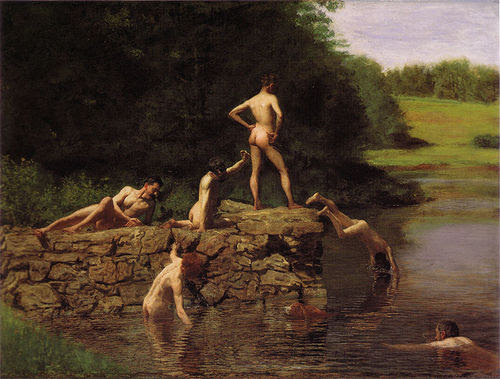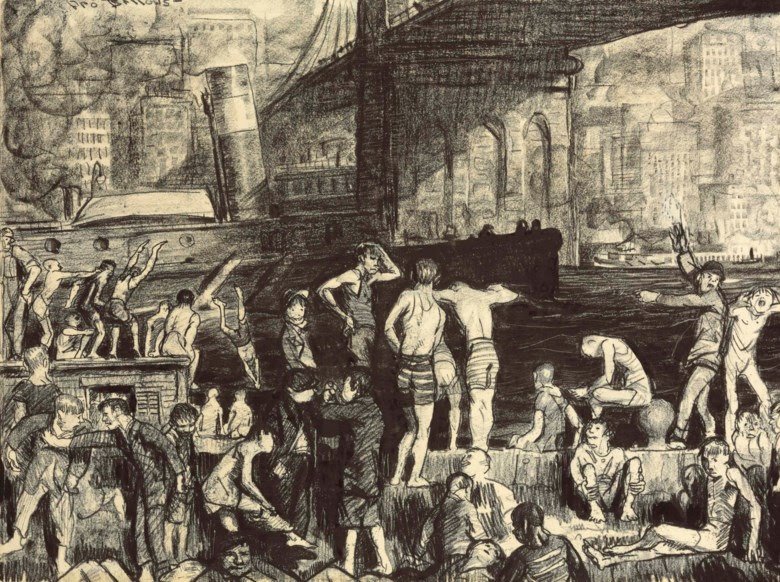Friday, December 18, 2020 – The single image of a deer is so inspiring of one thriving in its environment


FRIDAY, DECEMBER 18th, 2020
The
239th Edition
From Our Archives
DEER IN THE WOODS

Jinny Ewald sent this to us this morning from Long Island
PRISONERS, SWIMMERS AND OTHERS WHO ENDED UP IN THE EAST RIVER

In the East River Our Island is covered – lightly – in the first snow of the year. It is very cold. So it’s a good time to talk about dipping our toes in the East River.
Come with me on a modest tour d’horizon of getting wet in the River. First, getting off the Island the hard way. Did Blackwell’s Island prisoners escape by swimming off the island?
There’s no Blackwell’s Island myth like that of escape from Alcatraz. The place seems to have been buttoned up quite effectively. Visitors were not allowed on the Penitentiary grounds without a permit from the Commissioners. Sentinels were stationed along the water fronts, and guard-boats patrolled the river to prevent the escape of convicts.
Still, despite spite these precautions, the website of Corrections History informs us, “men have succeeded in making their escape to the opposite shore.”
There’s a record of twelve nude men swimming for freedom from the Island in 1853. They were seen coming out of the water at what is now Long Island City, but there’s no record if they were caught. In 1875 Dutch Harmon, a highwayman described by The New York Times as “one of the most desperate criminals in the country,” organized the mass escape of seven prisoners while wearing a ball and chain. Which must have made swimming problematic. And, of course, who could forget the saga of “Oily” Rockford, 22, the lad with a penchant for jail-breaking, who was recaptured in June 1922, a year after having gone missing from the Penitentiary. The Times reported that Rockford promised to escape again in time to bask in the sunshine of September. But we don’t know if he did.
No, getting into the River does not appear to have been a frequent maneuver for prisoners.
Well then, second, what about jumping?
Oddly enough, our bridges seem not to have been favored by the suicide-minded.
More people have tried to leap from the George Washington Bridge and, lesser, the Brooklyn Bridge. And while some have tried our own Queensboro Bridge, the numbers are fairly low. But nothing here compares with San Francisco’s Golden Gate.

However, more than 235 folks did actually apply for permission to jump off the Queensboro Bridge on the opening day celebration, June 12, 1909. The Celebration Committee analyzed the requests and classified them in this way:
Women (18-32): 30
Professionals: 168
Freaks: 34
Would-be suicides: 9
Unemployed: 24
You may relieved to learn that the Celebration Committee announced that no bridge jumping will be allowed.
OK. What about involuntary swimming? I mean those iconic “concrete shoes”. A myth punctured. The credibility of the “cement shoes” myth is pretty thin.

“The story of cement shoes is, in my opinion, a twisted-over-time variation of something that did actually happen,” said Christian Cipollini, author of Lucky Luciano: Mysterious Tales of a Gangland Legend. He explains that the myth originated in the 1930s and 1940s after the American mafia shifted from bootlegging during prohibition to other illicit ventures like drug trafficking and loansharking, and began infiltrating labor unions, and legitimate industries such as textiles and construction. Cipollini said there are no credible instances of a mafia murder victim being fitted with cement shoes around this time, but there is the story of Abe “Bo” Weinberg, a Jewish mobster in New York who worked closely with prohibition kingpin Dutch Schultz. Weinberg disappeared in 1935, supposedly after Schultz had him killed and disposed of his body in the East River after fitting him with a pair of cement shoes. “That much may indeed be true, but it was one of many of the tall tales that further evolved into a truism of sorts, that was basically ‘accepted’ as such by historians, press and mafia history aficionados.”
And from another expert: “So let’s review what we know: (1) Underworld gossips have repeatedly insisted that mob hit men sometimes encase a victim partially or completely in concrete. (2) However, the one confirmed instance of a concretized corpse we’ve been able to turn up wasn’t a mob hit. (3) In cases of mob hits definitively known to involve concrete, we’re not talking concrete shoes so much as concrete anchors, in the form of blocks used to keep the body submerged. We have no evidence of a mob hit in which the killer mixed up concrete, planted a victim in it, and (not to fixate on this, but one has to consider the practical aspects) waited for the stuff to dry. Conclusion: Either custom concretewear is 100 percent effective, and the victim invariably vanishes forever from the ken of man, or the whole thing’s a myth.”

We know there were floating baths in the late 1800s. The barge-shaped, wooden structures surrounded a pool—open on top to the air and to the dirty river water on the bottom. In 1915, there were 15 baths berthed around the city, but by 1940 or so they had all closed because of water pollution.
And we know that in 2004, the Neptune Foundation purchased the C500, one of dozens of single-hull, flat-top, metal barges flooding the market. The vessel, renamed The Floating Pool Lady, was repurposed with a half-Olympic-sized pool, sunk into a cutout in the barge.

But while the picture shows kids having fun, the baths were made less for recreation than to remedy New York’s dire public health plight. Political reformer Josiah Quincy said: “The advance of civilization is largely measured by the victories of mankind over its greatest enemy – dirt.” And public bathing was at the forefront of this.
The floating baths were built along the East and Hudson Rivers from 1870, and by 1888 around 2,500,000 men and 1,500,000 women used them every year during bathing season (June to September). The baths were free. However, they were such a welcome relief from the summer heat that there was often conflict.
The city imposed a 20-minute time limit in an effort to restrict lingering. But there were accusations of patrons bribing attendants to turn a blind eye. Young boys were more innovative, and often went from one bath to another, dirtying themselves on the way so as not to be denied admittance.
Early in the 20th century, pollution of the river water reached serious levels and so, in 1914, all floating baths were required to be watertight. If river water was used, it had to be purified and filtered. The need for year-round bathing also meant the need for indoor public baths.
But if we want to think of swimming in the East River, let’s end this odd tour with several works by Thomas Eakins & George Bellows, who really caught the idea.
Thomas Eakins The Swimming Hole 1884
George Bellows Splinter Beach 1 913
Stephen Blank
RIHS
December 17, 2020
Sources
https://www.nytimes.com/2012/02/12/realestate/streetscapes-the-penitentiary-on-roosevelt-island.html
http://www.correctionhistory.org/html/chronicl/nycdoc/html/blakwel3.html
New York Times, June 22, 1922
http://animalnewyork.com/2015/over-200-people-volunteered-to-jump-off-the-queensboro-bridge-on-opening-day
https://www.vice.com/en/article/vb8q8a/new-york-murder-mystery-a-body-with-concrete-shoes-washed-ashore-in-brooklyn
https://www.chicagoreader.com/chicago/were-concrete-shoes-a-favored-technique-of-mob-hitmen/Content?oid=861482
https://ephemeralnewyork.wordpress.com/tag/swimming-in-the-east-river/

Our flock of owls and our neighborhood squirrels are waiting to greet you at the Kiosk today.
We will be open today,
FRIDAY from 1 to 7 p.m.,
SATURDAY & SUNDAY 11 a.m. to 4 p.m.
MONDAY, DEC 21 1 p.m. to 7 p.m.

THE COLER AUXILIARY NEEDS YOUR SUPPORT TO PROVIDE FOR THE RESIDENTS OF COLER
PLEASE CONTACT US TO MAKE A TAX DEDUCTIBLE DONATION.
JUDITH BERDY CHAIR
JBIRD134@AOL.COM
212-688-4836
FRIDAY PHOTOS OF THE DAY
SEND YOUR SUBMISSION TO:
ROOSEVELTISLANDHISTORY@GMAIL.COM

THURSDAY PHOTO OF THE DAY
City Hospital with the Nurses Residence to the south, pier for steamer landings, with Queensboro Bridge north.
Jay Jacobson got it right!!

Text by Judith Berdy
Thanks to Bobbie Slonevsky for her dedication to Blackwell’s Almanac and the RIHS
Thanks to Deborah Dorff for maintaining our website
Edited by Melanie Colter and Deborah Dorff
Roosevelt Island Historical SocietyMATERIALS USED FROM:
NYC MUNICIPAL ARCHIVES.
FUNDING PROVIDED BY ROOSEVELT ISLAND OPERATING CORPORATION
PUBLIC PURPOSE GRANTS
CITY COUNCIL REPRESENTATIVE BEN KALLOS DISCRETIONARY FUNDING THRU DYCD
FUNDING PROVIDED BY ROOSEVELT ISLAND OPERATING CORPORATION PUBLIC PURPOSE GRANTS CITY COUNCIL REPRESENTATIVE BEN KALLOS DISCRETIONARY FUNDING THRU DYCD


Copyright © 2020 Roosevelt Island Historical Society, All rights reserved.
Our mailing address is:
rooseveltislandhistory@gmail.com



Leave a comment